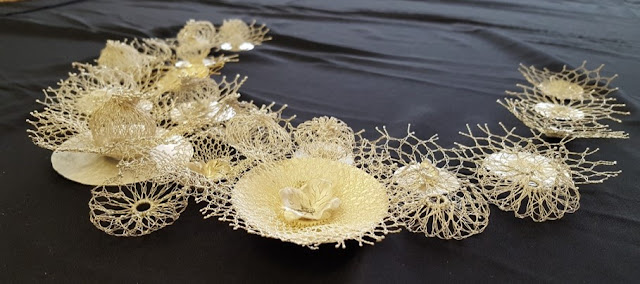In this post I would like to focus on linking the piece to the research component. The title for my research is: Lace Jewellery: Weaving Identities in Contemporary Jewellery.
Abstract
The purpose of this study is to examine and investigate the gendered identities of feminism and its associations with metallic and lace inspired jewellery. This will be achieved by creating lace jewellery pieces and providing a semiotic analysis on each piece. This research provides a comparative analysis between the alternative material of lace and lace jewellery, and explores the associated gendered assumptions. However, my main focus would be to analyse whether the material and context used plays an important role in feminine inspired designs of lace jewellery.
I am mindful that society is deeply gendered; however, historically the linkages with lace has evolved from being asexual to contemporary associations of deeply sexual connotations. On some levels the manufacturing of lace remains a practice that resides in the domestic and craft domain. The first phase of this study explores and plots the role of lace in history as well as in a masculine and feminine world, however it being limited to the feminine readings and links the wearable role of lace in a jewellery context to both a masculine and feminine context.
The second phase looks at the transformation of lace production from fabric to metal by looking at lace jewellery produced by two jewellery designers. I provide a semiotic analyses on the pieces, linking it to design aspects associated to women, in lace. I also find that although a more geometric structure is used it remains true to the feminine stereotypes of design as demonstrated in delicate lines, floral patterns, and soft, organic design motifs and is considered to be aesthetically beautiful. I argue that that such design motifs are attractive and beautiful, and it also reflects the constructed and gendered identities in the creative arts and practices. In the third phase of this study I provide a semiotic analysis on the pieces created, and I explore the possibility of whether such domesticated skill can be associated to fine jewellery, while fulfilling historical role and function of adornment. I also argue in a metaphorical analyses between the complexities of the piece in comparison to the simplicity, which represents a fragmented feminine identity. I propose that the complexity of the piece in all aspects focusses and could possibly relate to the multiple feminine identities.
 |
| Mariambibi Khan. 2015. Experimental Lace Components. Fine Silver & Sterling Silver. |
Once the decision was made to create a necklace, I began placing the experimental components together in order to analyse the combination. Once the components were placed together it became evident that in order to design the piece to its best representation of the study, I would require many more components all ranging from the examples made previously.
 |
| Mariambibi Khan. 2015. Experimental Lace Components with Flowers. Fine Silver & Sterling Silver. |
The flowers used are the same ones which were made in the beginning of the year. The reason for incorporating them is to provide a solid contrast to the delicate aspect of the lace. When the lace is placed around the wrist it is a one dimension form however, still visually appealing. After placing the lace on a wrist, it allowed me to analyse and decide on creating many one dimensional lace pieces as the base of the necklace. Then building onto it with the dimensional examples made.
 |
| Mariambibi Khan. 2015. 32 Point Lace with flower. Fine Silver & Sterling Silver. |
 |
| Mariambibi Khan. 2015. 32 Point Lace with flower on wrist. Fine Silver & Sterling Silver. |
The next step was to place it on a bodice in order to examine the way in which it should be placed and connected on the body.
 |
| Mariambibi Khan. 2015. Lace Components on Bodice. Fine Silver & Sterling Silver. |
Due to the long hours needed for one lace component in comparison to the time I had left, the chances of completing the piece seemed slim. I then decided that the base of the necklace will be created with a 15 point lace instead of a 32 or 40 point lace. This allowed for a quicker production of lace components to create the base of the necklace. Using a 15 point lace for the base of the necklace enhance the contrast of the 32 and 40 point lace.
 |
| Mariambibi Khan. 2015. 15 Point Lace - Beginnings. Fine Silver & Sterling Silver. |
 |
| Mariambibi Khan. 2015. 15 Point Lace - Production. Fine Silver & Sterling Silver. |
After mapping out these elements, the production of multiple lace pieces begun.
 |
| Mariambibi Khan. 2015. Rings. Sterling Silver. |
 |
| Mariambibi Khan. 2015. Wire. Fine Silver. |
 |
| Mariambibi Khan. 2015. 15 Point Lace - Production - Complete. Fine Silver & Sterling Silver. |
 |
| Mariambibi Khan. 2015. 4 leaf lace - Complete Production. Fine Silver & Sterling Silver. |





















































